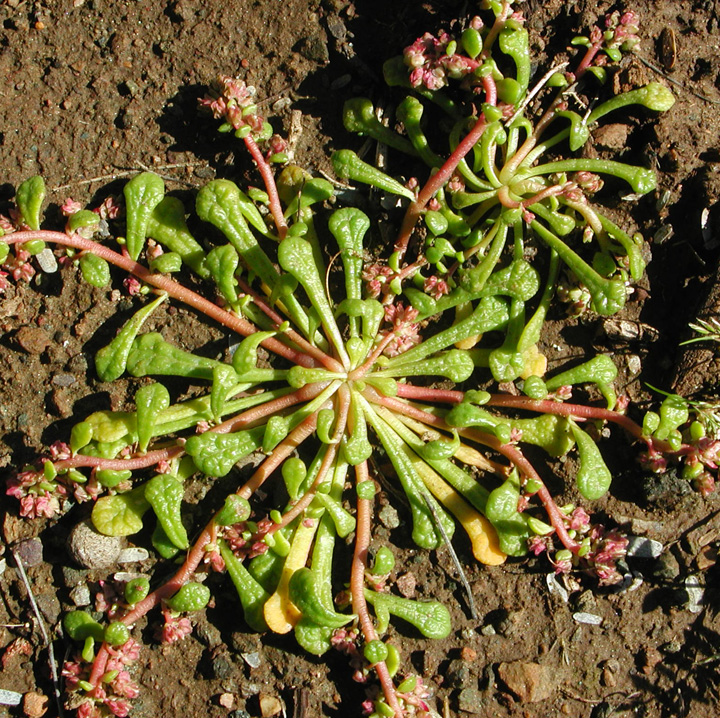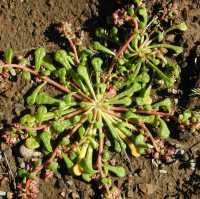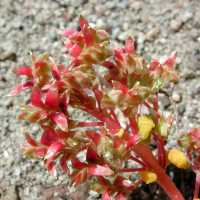Plants annual, taprooted. Stems 2 or more from each rosette, spreading to decumbent, 1.5-18 cm. Leaves basal and cauline; basal withering in fruit, in single, prostrate rosette, blade spatulate, 1-5 cm; cauline leaf blades spatulate, 1-2(-4) cm. Inflor-escences racemose or paniculate cymes, scorpioid when immature, loose. Flowers subsessile; sepals ovate, unequal, 1-2 mm, herbaceous, margins scarious; petals (2-)3, pink to reddish, 1-3 mm; stamens 1(-3), anther yellow; style absent; stigmas 2. Capsules ovoid to cylindric, somewhat falcate, 4-8 mm; valves 2. Seeds 4-10, black, orbicular, 0.3-0.7 mm, shiny. 2n = 44.
Flowering Mar-Jun. Open sandy areas, burns; 0-2100 m; Ariz., Calif., Nev.; Mexico (Baja California).
Annual herbs to 16 cm tall.
STEMS: spreading to ascending.
LEAVES: in an ephemeral basal rosette, spatulate, to 7.5 cm long.
INFLORESCENCE: a 1-sided raceme, up to 3.5 cm; bracts ovate to elliptic.
FLOWERS: sessile; sepals scarious or scarious-margined, ovate, 1-3 mm long; petals 3, white to pinkish, 1-3 mm long; stamen 1; styles absent; stigmas 2, sessile.
CAPSULE: with 2 valves, ovoid to cylindric, 2.5- 8 mm long, two and a half or more times as long as sepals.
SEEDS: 1-10, black, smooth, shiny
NOTES: Sand and gravel washes, rocky slopes, roadsides: Cochise, Gila, Graham, Maricopa, Mohave, Pima, Pinal, Santa Cruz, Yavapai, Yuma cos.; 400 - 1550 m (1400 - 5000 ft); Feb-May; CA, NV, Mex. (Baja C.).
REFERENCES: Allison Bair, Marissa Howe, Daniela Roth, Robin Taylor, Tina Ayers, and Robert W. Kiger., 2006, Vascular Plants of Arizona: Portulacaceae. CANOTIA 2(1): 1-22.
Duration: Annual
Nativity: Native
Lifeform: Forb/Herb
General: Small, glabrous, somewhat succulent-stemmed herb, branching from the base, stems prostrate or lying flat on the ground.
Leaves: Alternate, linear-spatulate, petiolate, 2-6 cm long, mostly in a basal rosette.
Flowers: Small, perfect, pink or white,ephemeral, petals 2-4, borne in loose scorpioid racemes, flowers not overlapping, sepals 2, rounded, stamens 1-3.
Fruits: Capsules sickle-shaped, acute to obtuse, seeds few to many, black.
Ecology: Found on desert plains and slopes, from 5000 ft or below 5,000 ft (1524 m); flowering March-May.
Notes: Look for this species under Calyptridium monandrum.
Ethnobotany: The seeds of this plant were used as food.
Synonyms: Calyptridium monandrum
Editor: LCrumbacher, 2011
Etymology: Cistanthe is presumably from the genus name Cistus and the Greek anthos, "flower".











